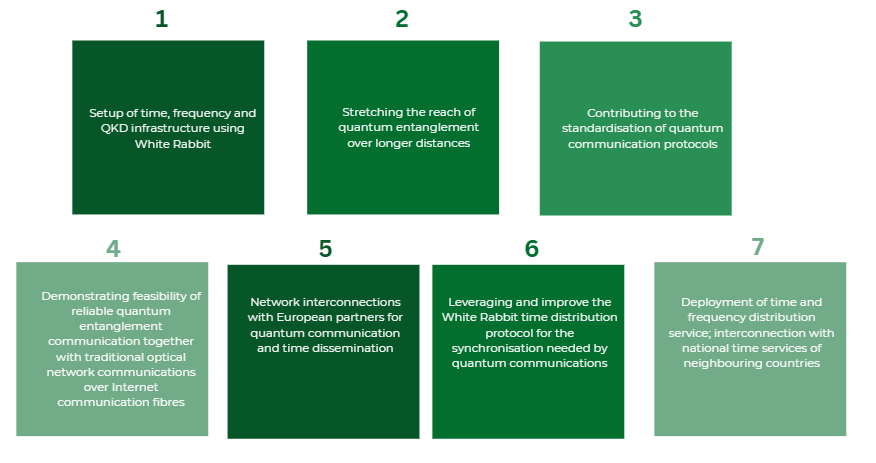At a Glance
Networks and communication have always been essential to science in general and for HEP specifically. In the ‘80s, the need for CERN to distribute data and share knowledge lead to the Internet that we know and use today: CERN was the main and fastest Internet hub in Europe to better distribute the data coming from the LEP accelerator; and CERN invented and made public the WWW principles and protocols to easily and openly distribute information. For its own interest and as a general support to open science programmes, CERN must play a central role also in the development of an open quantum infrastructure and communication inter-network as it did it for the Internet in its early stage. Thanks to its central position in Europe and being already very well interconnected to the Research and Education Networks (REN) of several countries in Europe, North America and Asia, CERN can act as a Quantum eXchange Point where different quantum players can interconnect their resources. CERN can do it by supporting the necessary infrastructure, similarly to what was done by the CERN Internet eXchange Point (CIXP) for the Internet starting from functionality like time and frequency distribution of more direct interest and impact to physics experiments and ultimately becoming a reference node as part of international quantum communication infrastructures.
Description
For CERN to be able to take part in the construction of the next generation of computing and data infrastructures, it is important to gain experience on the use of existing and upcoming technologies, assess and advance the state of the art the in provisioning of suitable communication channels, while at the same time establishing collaborations with the major quantum networks and communication players in academia and industry. This Centre of Competence aims at establishing at CERN the right level of expertise and in integrating in the CERN network the necessary equipment and expertise to become a node in the European quantum communication networks being set up. The Centre of Competence is organised in two specific objectives respectively focused on the physical layer and the protocols, and on the applications and experiments making use of the quantum infrastructures.
Another key interest for CERN is to interconnect different high-precision clocks and time distribution networks being developed in the neighbouring countries to facilitate the establishment of absolute time references for physics and astrophysics applications. Again, CERN being located in a strategic position at the centre of Europe, being interested in the utilisation of the signal for its accelerator and experiments, being the designer and developer of the open standard time distribution protocol White Rabbit, CERN can play a leading role in this activity. Several strategic discussions with regional metrology institutes have indeed already started.
Both activities of interest are related, since the same network infrastructure could also be used to support other types of content, including Quantum Key Distribution (QKD). At this stage of quantum communication, QKD is among the few applications making an effective and practical use of photon entanglement. However, in the future, similar quantum communication technology will be needed to interconnect quantum computers and enable future distributed quantum computing infrastructures.
Experiments with quantum communication devices and protocols are not new at CERN. In 2009, the Organization already took part in the SwissQuantum project, a public-private initiative to set up and operate over long periods of time a prototype QKD layer.
CERN plays an important role in regional and European Internet infrastructures at the physical layer. For example, it has hosted the CERN Internet eXchange Point (CIXP) since 1996, and it has been a driving force behind the evolution of the regional internet infrastructure. The CIXP is a founding member of the European Internet Exchange Point Association (Euro-IX). Technologies core to communications systems, like time synchronisation or lasers, have been developed for CERN applications and then moved to other fields.
For the past 20 years, CERN has played a leading role in the design, deployment, and operations of the Worldwide LHC Computing Grid (WLCG), at the base of the revolution that has led to modern distributed computing infrastructures and Cloud computing.
Taking part in technology investigations and supporting the deployment and operations of the future Quantum Internet would not only be a natural extension of CERN's current mission but would also ensure that CERN continues to play a central role in the future of European and international communication infrastructures.
Objectives

Synergies
Work related to WR for Quantum will be pursued within the framework of the White Rabbit Collaboration launched by CERN in 2024, you can find more information here: www.white-rabbit.tech
The possibility of exploiting a large number of distributed resources to analyse heterogeneous data, especially for medical or biological applications, is hampered by the fact that often such data contain sensitive information or is protected by policies and usage agreements that do not allow the data to be shared. However, the recent pandemic and the many unsolved health challenges (HIV, neurological and mental conditions, overstressed healthcare systems, to mention a few) require a different approach to data collection, sharing and analysis. Traditional approaches like (pseudo-) anonymisation require compromises between privacy preservation and information content preservation.
Novel techniques to encrypt the data (such as homomorphic encryption) or move the data across provably secure connections might turn the tide. Projects like openQKD, part of the European Quantum Flagship strategy, and others are investigating the feasibility of large-scale QKD networks. CERN is currently involved in the development of an end-to-end QKD-based secure data analytics demonstrator, Quantumacy, that proposes to advance the application of cryptographic techniques, federated learning and QKD to distributed data processing.
Discussions to set up joint research in this area are now taking place with infrastructure providers, such as GEANT in Europe, and domain experts in the industry (IDQ) and research (PSNC in Poznań).
Several technologies have been developed at CERN over the years to support specific needs of the Accelerators Complex, such as time synchronisation or alignment of physical components along the LHC 27 km path. Such technologies have applications outside their original intent, in particular in quantum computing and quantum communications.
A significant example is the White Rabbit (WR) technology developed at CERN to provide sub-nanosecond accuracy and picoseconds precision of synchronisation for the LHC accelerators chain. It was first used in 2012 and since then has been showcasing its diverse industrial applications outside the field of particle physics. On 16 June, the Institute of Electrical and Electronics Engineers (IEEE) updated the Precision Time Protocol industry-standard (PTP), incorporating the White Rabbit PTP extension and thus maximising its adoption by industry and other partners in their pursuit to build innovative solutions to address world challenges.
This Ethernet-based technology, which ensures sub-nanosecond synchronisation and deterministic data transfer, is now deployed in numerous scientific infrastructures worldwide. It has shown its innovative potential by being commercialised and introduced into different industries, including telecommunications, financial markets, smart grids, space industry and of course, quantum computing and communication. Discussions for further joint co-development of this technology specifically for quantum communications are taking place with industrial and research technology providers.
Another example is the possible applications of structured laser beams. A structured laser beam system, developed by a team of CERN surveyors in collaboration with the Institute of Plasma Physics in Prague (IPP), is currently already deployed in communications applications, and there is interest in investigating the potential applications in quantum communications. The structured laser beam system is capable of producing beams that are virtually non-diffractive over several hundred metres, whereas systems currently available on the market produce such beams over a distance of only a few metres.
